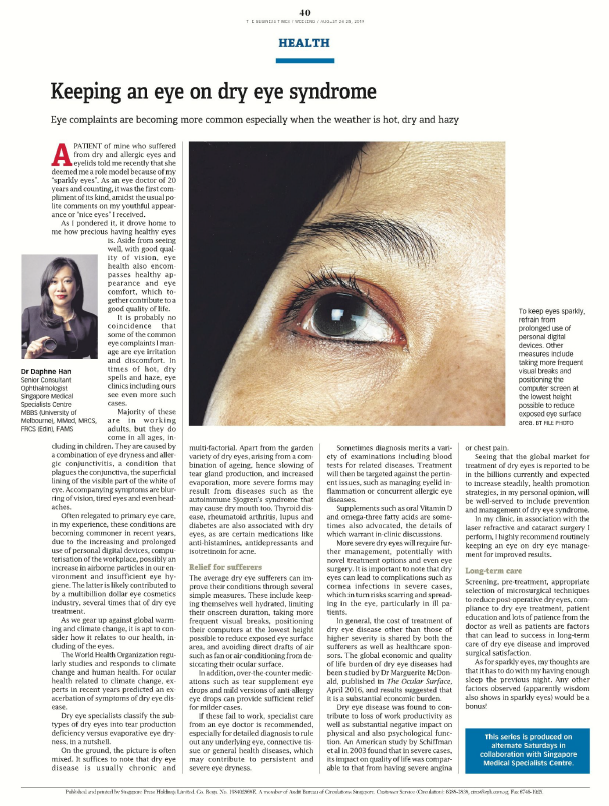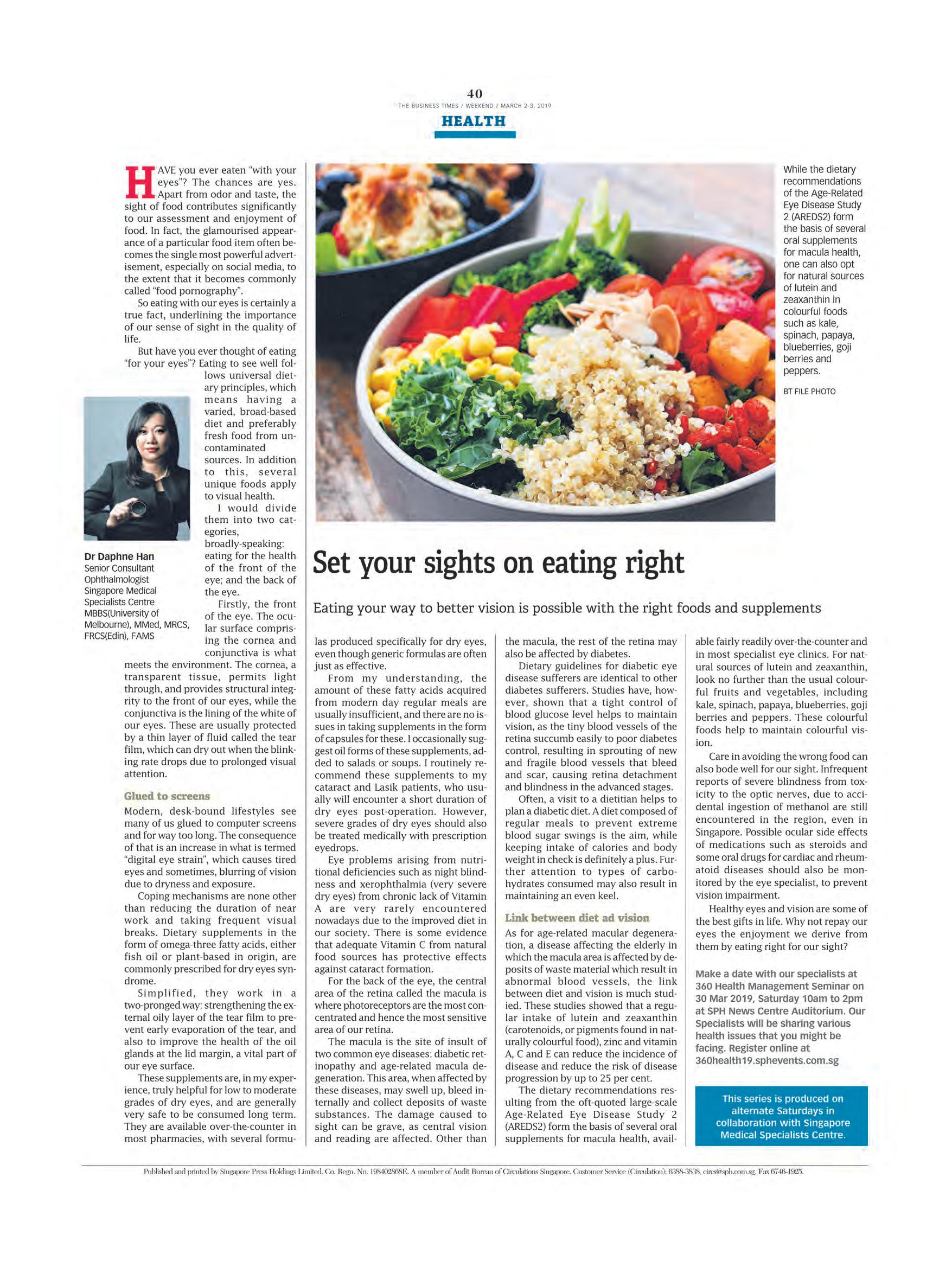Keeping an eye on dry eye syndrome
Eye complaints are becoming more common especially when the weather is hot, dry and hazy
A Patient of mine who suffered from dry and allergic eyes and eyelids told me recently that she deemed me a role model because of my “sparkly eyes”. As an eye doctor of 20 years and counting, it was the first compliment of its kind, amidst the usual polite comments on my youthful appearance or “nice eyes” I received.
As I pondered it, it drove home to me how precious having healthy eyes is. Aside form seeing well, with good quality of vision, eye health also encompasses healthy appearance and eye comfort, which together contribute to a good quality of life.
It is probably no coincidence that some of the common eye complaints I manage are eye irritation and discomfort. In times of hot, dry spells and haze, eye clinics including ours see even more such cases.
Majority of these are in working adults, but they do come in all ages, including children. They are caused by a combination of eye dryness and allergic conjunctivitis, a condition that plagues the conjunctiva, the superficial lining of the visible part of the white of eye. Accompanying symptoms are blurring of vision, tired eyes and even headaches.
Often relegated to primary eye care, in my experience, these conditions are becoming commoner in recent years, due to the increasing and prolonged use of personal digital devices, computerization of workplace, possibly an increase in airborne particles in our environment and insufficient eye hygiene. The latter is likely contributed to by a multi-billion dollar eye cosmetics industry, several times that of dry eye treatment.
As we gear up against global warming and climate change, it is apt to consider how it relates to our health, including the eyes.
The World Health Organization regularly studies and responds to climate change and human health. For ocular health related to climate change, experts in recent years predicted an exacerbation of symptoms of dry eye disease.
Dry eye specialists classify the sub-types of dry eyes into tear production deficiency versus evaporative eye dryness, in a nutshell.
On the ground, the picture is often mixed. It is suffices to note that dry eye disease is usually chronic and multi-factorial. Apart from the garden variety of dry eyes, arising from a combination of ageing, hence slowing of tear gland production, and increased evaporation, more severe forms may result from diseases such as the autoimmune Sjogren’s syndrome that may cause dry mouth too. Thyroid disease, rheumatoid arthritis, lupus and diabetes are also associated with dry eyes, as are certain medications like anti-histamines, antidepressants and isotretinoin for acne.
Relief for sufferes
The average dry eye sufferers can improve their conditions through several simple measures. These include keeping themselves well hydrated, limiting their onscreen duration, taking more frequent visual breaks, positioning their computers at the lowest height possible to reduce exposed eye surface area, and avoiding direct drafts of air such as fan or air-conditioning from desiccating their ocular surface.
In addition, over-the-counter medications such as tear supplement eye drops and mild versions of anti-allergy eye drops can provide sufficient relief for milder cases.
If these failed to work, specialist care from an eye doctor is recommended, especially for detailed diagnosis to rule out any underlying eye, connective tissue or general health disease, which may contribute to persistent and severe eye dryness.
Sometimes diagnosis merits a variety of examinations including blood tests for related diseases. Treatment will then be targeted again the pertinent issues, such as managing eyelid inflammation or concurrent allergic eye diseases.
Supplements such as oral Vitamin D and omega-three fatty acids are sometimes also advocated, the details of which warrant in-clinic discussions.
More severe dry eyes will required further management, potentially with novel treatment options and even eye surgery. It is important to note that dry eyes can lead to complications such as cornea infections in severe cases, which in turn ricks scarring and spreading in the eye, particularly in ill patients.
In general, the cost of treatment of dry eye disease other than those of higher severity is shared by both the sufferers as well as healthcare sponsors. The global economic and quality of life burden of dry eye diseases had been studied by Dr Marguerite McDonald, published in The Ocular Surface, April 2016, and results suggested that is is a substantial economic burden.
Dry eye disease was found to contribute to loss of work productivity as well as substantial negative impact on physical and also psychological function. An American study by Schiffman et al in 2003 found that in severe cases, its impact on quality of life was comparable to that from having severe angina or chest pain.
Seeing that the global market for treatment of dry eyes is reported to be in the billions currently and expected to increase steadily, health promotion strategies, in my personal opinion, will be well-served to include prevention and management of dry eye syndrome.
In my clinic, in association with the laser refractive and cataract surgery I performed, I highly recommend routinely keeping an eye on dry eye management for improved results.
Long-term care
Screening, pre-treatment, appropriate selection of microsurgical techniques to reduce post-operative dry eyes, compliance to dry eye treatment, patient education and lots of patience from the doctor as well as patients are factors that can lead to success in long-term care of dry eye disease and improved surgical satisfaction.
As for sparkly eyes, my thoughts are that it has to do with my having enough sleep the previous night. Any other factors observed (apparently wisdom also show in sparkly eyes) would be a bonus!
Straits Times Life
24-25 August 2019


